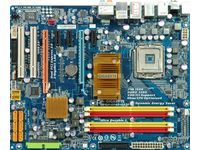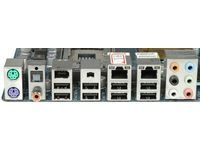Power-Saving Motherboards: Fact Or Fiction?
Gigabyte GA-EP45-DS3R: DES Power-Saving
Board Features

The DS3R is Gigabyte’s upper-mainstream motherboard, implementing several features enthusiasts want—including power-saving options. Experts will immediately recognize that this isn’t a high-end Gigabyte board because it lacks the SilentPipe, a complex, higher-end heat pipe cooling solution. This board doesn’t come with such a massive array of copper, and the 12-phase voltage regulator of the DQ6 series has been replaced by six phases, which we consider sufficient. (We won’t discuss the cooling and overclocking abilities of the EP45-DS3R motherboards; suffice to say they allow setting DDR2 memory to 1333+ speeds—which hardly any module on the market can reach—and have tested excellently in the past.)
Features
This motherboard comes with two 32-bit PCI slots for legacy hardware, as well as three x1 PCIe slots and two x16 PCIe slots; the latter allows installation of AMD CrossFireX-compatible graphics cards to enable multi-graphics setups. The board has two Gigabit networking ports, diagnostic LEDs to facilitate debugging and troubleshooting, twin flash chips to provide a backup BIOS (DualBIOS), and hardware ICs for overvoltage control, among other features.
DES—It Worked, But Didn’t Change Much

Gigabyte was one of the first motherboard makers to implement power-saving circuits that dynamically switch voltage regulators on and off depending on processor workload. This principle, known as Dynamic Energy Saver (DES), extends to the memory and graphics power supply, as memory and northbridge voltage regulators are based on a twin-phase voltage supply. It switches the six-voltage regulator phases on and off as if they were gears in a manual transmission.
Unfortunately, DES doesn’t provide the energy savings we’d expect. We might get great results comparing power consumption when all power-saving options are off with power consumption when DES is enabled. However, we compared DES-enabled performance with ordinary CPU power-saving options (Enhanced Intel SpeedStep and C-states) and found nothing to write home about.
Stay on the Cutting Edge
Join the experts who read Tom's Hardware for the inside track on enthusiast PC tech news — and have for over 25 years. We'll send breaking news and in-depth reviews of CPUs, GPUs, AI, maker hardware and more straight to your inbox.




Current page: Gigabyte GA-EP45-DS3R: DES Power-Saving
Prev Page Foxconn P45A-S: No Special Power-Saving Feature Next Page MSI P45 DiamondMost Popular

